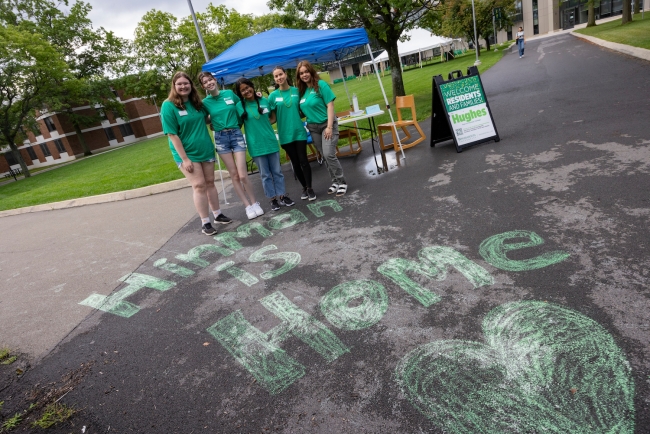You have /5 articles left.
Sign up for a free account or log in.

Residential life student staff members at Binghamton University greet first-year students.
Binghamton University
The resident assistants at Binghamton University were tired and stressed. Not only were they each responsible for keeping watch over students in a dorm, but they also faced a laundry list of other responsibilities: crisis management, event planning, health and safety inspections—even marketing.
“We were expecting an undergrad student to be good at all things,” said Paola Mignone, assistant vice president for residential experiences and auxiliaries at Binghamton.
It was clear the job had gotten too big, Mignone said. In multiple years of RA surveys, the student workers reported feeling burned out—especially by the mental health and crisis-response elements of the job. The Department of Residential Life, with the help of other campus partners, then cataloged everything RAs did, including both the duties listed in the official job description and those that had sneakily piled up on the side.
Based on that research, the residential life office decided to divide the traditional RA role into several new undergraduate jobs—some live-in and some hourly—starting in the fall 2023 semester.
One of the new live-in roles, community assistants, also known as CAs, are now responsible for the core community-building aspects of the RA job: planning events for the residents of their building, getting first-year students acclimated to campus and meeting with them regularly. But they no longer have to do “duty,” or be on call during set shifts to deal with emergent situations. That now falls to another new live-in role, the student support assistant, whose tasks also include conflict resolution and directing residents to other on-campus resources as needed.
Hourly roles include area assistants, who staff the offices within the campus’s residential buildings; marketing assistants, who promote residential life events on social media and around campus; operational assistants, who do health and safety inspections; and more. In total, there are 217 student workers in live-in roles—about the same as the number of RAs the university employed last year—and 250 in the hourly positions, on a campus with about 14,400 undergraduates.
Divvying up the work has made a big difference, said Miriam Toledo, an RA–turned–CA and marketing assistant, impacting not only her stress levels but also her ability to do her job well.
“I really like getting to know people, their interests … [so] I applied for community assistant,” said Toledo, a Binghamton junior who worked as an RA in the 2022–23 academic year. “The big change is not having duty. That’s been really helpful, because I can set that time aside to plan any events, and that’s kind of my priority now.”
Over all, 62 percent of student staff are planning to return to their roles next year, an improvement from 50 percent in previous years.
Binghamton is not the only institution that has reconsidered how to structure the RA position. According to Jason Lynch, an assistant professor of higher education at Appalachian State University whose research focuses on residential life, the role began growing about 20 years ago from supervising and supporting residential students to the all-encompassing grind it has become today.
“That peer-support role has sort of evolved and morphed in ways I don’t think anybody expected and ways we didn’t want it to,” he said. The issue has gotten to a point where, at some universities, beleaguered RAs have begun looking at unionizing in hopes of earning higher pay and better benefits, as well as less demanding schedules.
Plenty of factors have contributed to this shift. Perhaps most obviously, college student mental health has steadily declined in recent years; the Healthy Minds survey released in 2023 shows that the number of students reporting a mental health concern jumped 50 percent between 2013 and 2021. RAs have borne much of the burden of that change, since they are often the first point of contact for suffering students.
Hoping to maintain or boost enrollment, many colleges are also increasingly worried about providing a top-tier student experience, which can put pressure on residential life departments to ensure students feel welcome, Lynch said.
And, he added, colleges often lean on RAs to bring what they consider vital programming—from alcohol abuse prevention training to career services seminars—into the dorms, where students are something of a captive audience.
Filling in the Gaps
The challenge for college officials is to alleviate stress and pressure on the RAs—who are, after all, students themselves—without taking away resources that other students have come to depend on in the dorms.
For many campuses, the answer often involves handing over some of the most challenging elements of the RA’s job—usually crisis-response or mental health services—to another employee. About five years ago, Lynch said, some institutions began shifting that work to professional mental health counselors, social workers or even interns from the institution’s social work or psychology graduate programs.
Binghamton did just that; in fall 2021, it began placing social work graduate student interns in residential communities. Their duties might include mediating between roommates, meeting with students in distress and offering wellness checks, among other things.
Other universities that have taken similar measures include the University of North Carolina, which places wellness coaches—social work students—in residence halls; Ohio University, where three doctoral students provide free counseling as “counselors in residence”; and the University of Nebraska at Lincoln, which draws from its marriage and family therapy graduate program to offer counseling in the dorms.
Some institutions have joined Binghamton in going even further to lighten their RAs’ load. Clemson University in South Carolina, too, is currently in the process of divvying up the RA’s traditional responsibilities.
“Rather than ask one 19-year-old, 20-year-old undergraduate student to do all the things, we needed to start separating these things out,” said Leasa Evinger, director of residential living, pointing out that workers in these differentiated positions will also benefit from specialized recruitment and training.
RAs used to be required to take shifts at the desks in their residential communities, completing tasks like providing temporary key cards to students locked out of their rooms. Now those tasks fall to separate student staff members who are responsible only for staffing the desk, Evinger said.
Meanwhile, the traditional RA role has been redefined. Now known as residential community mentors, they are trained to focus on “relationship building and community building,” Evinger said, though they are still responsible for administrative tasks, like filling out incident reports. “We have gone out to find folks who have sort of an innate talent, skill, interest in really developing deep relationships, and we’ve been teaching them how to do that and prioritizing that within their work.”
Moving forward, the university also plans to create a specific position for handling on-call responsibilities.
The restructuring seems to be doing as much for improving the student experience as it has for lessening the burden on RAs. According to Evinger, this year, “record numbers” of students are involved in the residential governing councils, residential communities are seeing high turnout for events and increasing numbers of students report that they’ve “made a connection” since coming to campus.
But the shift hasn’t been without hiccups. Addison Langston, a former Clemson RA who is now an RCM, said that RAs who were brought on under the new model have struggled with the day-to-day administrative functions of the job—filling out incident reports, for instance—since their training centered on community-building skills.
“I understand what they were going for, but a lot of it led to issues with a lot of our new hires,” she said. “They did not feel prepared for some of the more practical elements.”
Evinger said that’s to be expected. Throughout her time at Clemson, she has routinely seen old skills atrophy when a training emphasizes something new. Residential life uses methods like supervision, staff meetings, development sessions and a “winter refresh” in January to reinforce any areas of concern.
Binghamton ran into a different issue: parents and students struggling to understand the distinction among the new roles.
“You get parents on tour and they say, ‘I heard you don’t have RAs?’” Mignone said. “And it takes a little longer to explain … ‘Look at this model we have that we believe, and data shows, is a better model for our students here at Binghamton.’”
But a 10-second explanation is a tiny price to pay for an effective new model.




